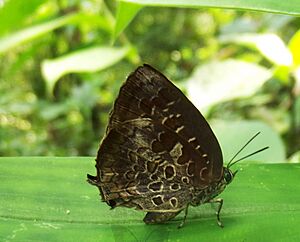Tamil oakblue facts for kids
Quick facts for kids Tamil oakblue |
|
|---|---|
 |
|
| Scientific classification | |
| Genus: |
Arhopala
|
| Species: |
bazaloides
|
| Synonyms | |
|
|
The Tamil oakblue (scientific name: Arhopala bazaloides) is a beautiful blue butterfly. It belongs to the lycaenid family, also known as the "blues" or "coppers." You can find this butterfly in different parts of Asia, including India, Myanmar, Sri Lanka, and Thailand.
Contents
What Does the Tamil Oakblue Look Like?
The Tamil oakblue butterfly has a stunning appearance. Both male and female butterflies have a deep purple-violet color on their upper wings.
Male and Female Differences
- Males: Their upper wings are a deep purple. They have a black band along the edges of their wings, which is about 3 millimeters wide.
- Females: Their upper wings are a brighter purple than the males. The black band along the edges is even wider. On their hindwings, the blue color is mostly found near the center.
Wing Patterns
The underside of their wings is brown. They have darker brown spots that are outlined with white, making them stand out. The hindwing (back wing) has a large light area underneath, with only the part near the front edge remaining darker and spotted.
The butterfly also has a small, narrow tail at the end of one of its wing veins. This tail is black with a white tip.
Life Cycle of the Tamil Oakblue
Like all butterflies, the Tamil oakblue goes through several stages in its life.
Eggs and Caterpillars
Female Tamil oakblue butterflies lay their eggs one by one. These eggs are shaped like sea urchins and are usually laid on the leaves or flower buds of host plants. When the eggs hatch, slug-shaped caterpillars emerge.
A Special Friendship with Ants
Many types of caterpillars, including some in this family, have a special relationship with ants. The caterpillars produce a sweet liquid called honeydew. Ants love to eat this honeydew, and in return, they protect the caterpillars from predators. This is called a symbiotic relationship, where both sides benefit.
Overwintering
Most Tamil oakblue butterflies spend the winter either as an egg or as a pupa. This helps them survive the colder months until the weather is warm enough for them to continue their development.
Where Do They Live?
The Tamil oakblue is found in various countries in Asia. It was once thought to have disappeared from Sri Lanka. However, in 2014, it was rediscovered in the wet lowland forests of Sinharaja and Kanneliya in Sri Lanka. This was exciting news for butterfly enthusiasts and conservationists!

